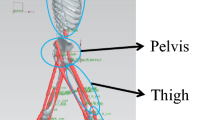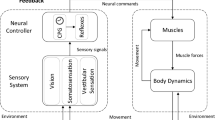Abstract
Spinal pattern generators (SPGs), which are neural networks without a central input from the brain may be responsible for controlling locomotion. In this study, we used neural oscillators to examine the rhythmic patterns generated at the ankle during walking. Seven healthy male subjects were requested to walk at their normal self-selected speed on a treadmill. Force measurements acquired from pressure insoles, electromyography and kinematic data were captured simultaneously. The SPG model consisted of a simple oscillator made up of two neurons; one neuron will activate an ankle extensor and the other will activate an ankle flexor. The outputs of the oscillator represented the muscle activation of each muscle. A nonlinear least squares algorithm was used to determine a set of parameters that would optimise the differences between model output and experimental data. Insole forces and hip angles of six consecutive strides were used as inputs to the model, which generated outputs that closely fitted experimental data. Our results showed that it is possible to reproduce muscle activations using neural oscillators. A close correlation between simulated and measured muscle activations indicated that spinal control should not be underestimated in models of human locomotion.



Similar content being viewed by others
References
Arsenault AB, Winter DA, Marteniuk RG (1986) Is there a normal profile of EMG activity in gait? Med Biol Eng Comput 24:337–343
Brown TG (1911) The intrinsic factors in the act of progression in the mammal. Proc R Soc Lond B 84:308–319
Brown TG (1912) The factors in rhythmic activity of the nervous system. Proc R Soc Lond B 85:278–289
Brown TG (1914) On the nature of the fundamental activity of the nervous centres; together with an analysis of the conditioning of rhythmic activity in progression, and a theory of the evolution of function in the nervous system. J Physiol 48:18–46
Dietz V (1992) Human neuronal control of automatic functional movements: interaction between central programs and afferent input. Physiol Rev 72:33–69
Dietz V, Duysens J (2000) Significance of load receptor input during locomotion: a review. Gait Posture 11:102–110
Dietz V, Quintern J, Boos G, Berger W (1986) Obstruction of the swing phase during gait: phase-dependent bilateral leg muscle coordination. Brain Res 384:166–169
Dietz V, Zijlstra W, Duysens J (1994) Human neuronal interlimb coordination during split-belt locomotion. Exp Brain Res 101:513–520
Dietz V, Colombo G, Jensen L, Baumgartner L (1995) Locomotor capacity of spinal cord in paraplegic patients. Ann Neurol 37:574–582
Dietz V, Mueller R, Colombo G (2002) Locomotor activity in spinal man: significance of afferent input from joint and load receptors. Brain 125:2626–2634
Dimitrijevic MR, Gerasimenko Y, Pinter MM (1998) Evidence for a spinal central pattern generator in humans. Ann N Y Acad Sci 860:360–376
Duysens J (2002) Human gait as a step in evolution. Brain 125:2589–2590
Duysens J, Van de Crommert HWAA (1998) Neural control of locomotion; part 1: the central pattern generator from cats to humans. Gait Posture 7:131–141
Duysens J, Clarac F, Cruse H (2000) Load-regulating mechanisms in gait and posture: comparative aspects. Physiol Rev 80:83–133
Duysens J, Van de Crommert HW, Smits-Engelsman BC, Van der Helm FC (2002) A walking robot called human: lessons to be learned from neural control of locomotion. J Biomech 35:447–453
Geyer H, Herr H (2010) A muscle-reflex model that encodes principles of legged mechanics produces human walking dynamics and muscle activities. IEEE Trans Neural Syst Rehabil Eng 18:263–273
Geyer H, Seyfarth A, Blickhan R (2003) Positive force feedback in bouncing gaits? Proc Biol Sci 270:2173–83
Grillner S, Wallen P (1985) Central pattern generators for locomotion, with special reference to vertebrates. Ann Rev Neurosci 8:233–261
Hermens HJ, Freriks B, Merletti R, Stegeman DF, Blok J, Rau G, Disselhorst-Klug C, Haegg G (1999) European recommendations for surface electromyography, results of the SENIAM project. Roessingh Research and Development, Enschede
Hirai K, Hirose M, Haikawa Y, Takenaka T (1998) The development of honda humanoid robot. In: Proceedings of the IEEE International Conference on Robotics and Automation, vol 2. Leuven, Belgium, pp 1321–1326
Hof AL, Elzinga H, Grimmius W (2002) Speed dependence of averaged EMG profiles in walking. Gait Posture 16:78–86
Ijspeert AJ (2008) Central pattern generators for locomotion control in animals and robots: a review. Neural Netw 21:642–653
Ijspeert AJ, Kodjabachian J (1999) Evolution and development of a central pattern generator for the swimming of a lamprey. Artificial Life 5(3):247–269
Ishiguro A, Fujii A, Hotz PE (2003) Neuromodulated control of bipedal locomotion using a polymorphic CPG circuit. Adapt Behav 11:7–17
Kimura H, Akiyama S, Sakurama K (1999) Realization of dynamic walking and running of the quadruped using neural oscillator. Auton Robot 7:247–258
Kleissen RFM (1990) Effects of electromyographic processing methods on computer-averaged surface electromyographic profiles for the gluteus medius muscle. Phys Ther 70:716–722
Kurtzer I, Pruszynski JA, Scott SH (2010) Long-latency and voluntary responses to an arm displacement can be rapidly attenuated by perturbation offset. J Neurophysiol 103:3195–3204
Matsuoka K (1985) Sustained oscillations generated by mutually inhibiting neurons with adaptation. Biol Cybern 52:367–376
Matsuoka K (1987) Mechanisms of frequency and pattern control in the neural rhythm generators. Biol Cybern 56:345–353
Maufroy C, Kimura H, Takase K (2008) Towards a general neural controller for quadrupedal locomotion. Neural Netw 21:667–681
McGeer T (1990) Passive bipedal running. Int J Robot Res 9:62–82
Ogihara N, Yamazaki N (2001) Generation of human bipedal locomotion by a bio-mimetic neuro-musculo-skeletal model. Biol Cybern 84:1–11
Pang MYC, Yang JF (2000) The initiation of the swing phase in human infant stepping: importance of hip position and leg loading. J Physiol (Lond) 528:389–404
Shiavi R, Frigo C, Pedotti A (1998) Electromyographic signals during gait: criteria for envelope filtering and number of strides. Med Biol Eng Comput 35:171–178
Sussillo D, Abbott LF (2009) Generating coherent patterns of activity from chaotic neural networks. Neuron 63:544–557
Taga G, Yamaguchi Y, Shimizu H (1991) Self-organized control of bipedal locomotion by neural oscillators in unpredictable environment. Biol Cybern 65:147–159
Taga G (1995) A model of the neuro-musculo-skeletal system for human locomotion. I. Emergence of basic gait. Biol Cybern 73:97–111
Williamson MM (1999) Designing rhythmic motions using neural oscillators. In: IEEE/RSJ International Conference on Intelligent Robots and Systems. Kyongju, Korea, IEEE Press, vol 1:494–500
Winter DA (1991) The Biomechanics and Motor Control of Normal Human Gait. University of Waterloo Press, Waterloo
Xu WL, Fang FC, Bronlund J, Potgieter J (2009) Generation of rhythmic and voluntary patterns of mastication using matsuoka oscillator for a humanoid chewing robot. Mechatronics 19:205–217
Acknowledgments
This study was supported by the German Federal Ministry of Education and Research (BMBF), project no. 01EC1003A. The authors would like to thank Hanno Focke and David Schinowski for their technical assistance, and Thomas Wulf, Kim Bostroem and Thomas Stief for helpful comments and suggestions.
Author information
Authors and Affiliations
Corresponding author
Rights and permissions
About this article
Cite this article
Chong, SY., Wagner, H. & Wulf, A. Neural oscillators triggered by loading and hip orientation can generate activation patterns at the ankle during walking in humans. Med Biol Eng Comput 50, 917–923 (2012). https://doi.org/10.1007/s11517-012-0944-2
Received:
Accepted:
Published:
Issue Date:
DOI: https://doi.org/10.1007/s11517-012-0944-2




